What Kinds Of Animals Live In The Ocean
Body of water animals list for kids (and adults) with pictures and facts. Detect amazing animals that live in the body of water.
Introduction
The ocean covers about 3-quarters of the Earth's surface and is one of the well-nigh important animal habitats. It is home to around 230,000 recorded species, and many more that are nonetheless to be discovered and named.
Biologists guess that the total number of species living in the globe'south oceans may be over i,000,000!
On this page you'll discover an A to Z list of ocean animals, together with pictures and facts about each animal. You'll as well find links that you lot tin follow in order to observe more information, plus a Gratuitous question canvas to test your knowledge!
Free Body of water Animals Worksheet Download

You lot tin download a gratuitous printable question canvas (in pdf format) for use with this folio hither. (No sign-upward required; just download and print.) For more than details see: Free Printable Worksheets.
Related Pages
- Rainforest Animals Listing
- Arctic Animals Listing
- Antarctic Animals List
- Desert Animals List
- African Animals List
- Australian Animals List
Body of water Animals List with Pictures & Facts
Boundness
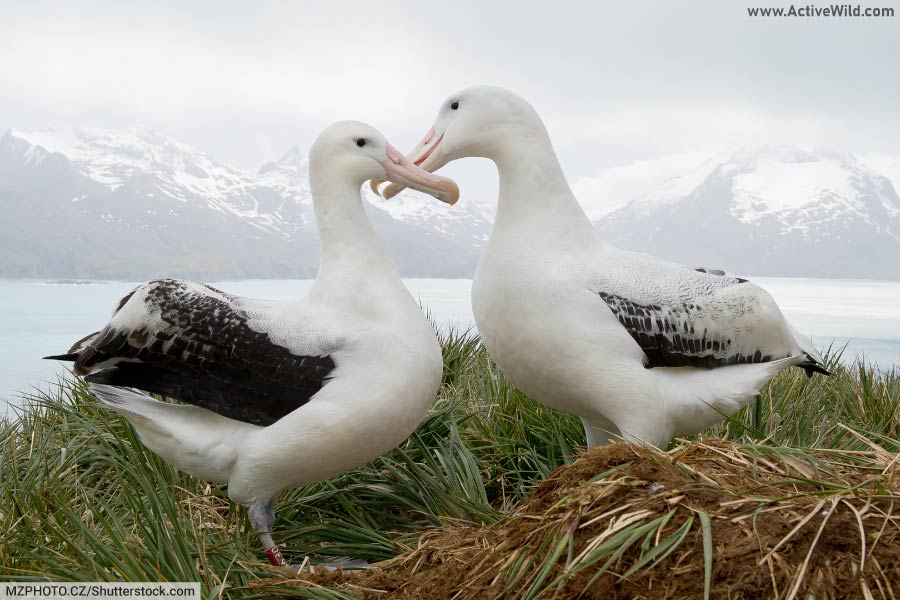
Albatrosses are large seabirds. They have long, narrow wings that allow them to wing great distances using very little energy.
There are around 21 species of albatross (scientists disagree over the exact number). Together they brand up the family Diomedeidae.
- You can find out more about brute groups such every bit families, orders and species on this page: Animal Nomenclature
The largest boundness is the wandering albatross. Its wingspan can reach three.vii m (12 ft.); the longest wingspan of any bird! (The southern regal albatross, a closely related species, is a similar size.)
Imagine ii tall men lying head to toe on the ground; that's the size of the albatross's wingspan!
Albatrosses feed on fish, squid, krill and zooplankton. They either find food on the surface of the bounding main or dive in to capture their casualty.
Albatrosses spend most of their lives at ocean. Some are known to travel all the way effectually the southern part of the world not once, not twice, but three times a year!
Find out more at Active Wild
- Birds: The Ultimate Guide
- Amazing Birds
Anglerfish

An anglerfish is a member of a group of carnivorous fish called the Lophiiformes. The group contains several different families, and includes fishes such equally the goosefishes, monkfishes, frogfishes, sea toads and seadevils.
Anglerfish are dull-moving ambush predators who get their name from the unique mode in which they grab their casualty.
Projecting from the top of the anglerfish's head is a long, bony 'arm'. A fleshy growth at the tip of the arm acts as a lure to tempt curious fish closer to the anglerfish. (Retrieve of a fisherman using a fake wing to take hold of a trout.)
When the unsuspecting fish comes within range of the anglerfish's fearsome jaws, the anglerfish strikes, capturing the prey in its long teeth!
Bivalves

Bivalves are a group of aquatic animals with shells. Near bivalves are body of water animals, but some live in freshwater habitats. A bivalve'due south beat out has 2 parts. These are hinged on one side, and can exist open up and airtight.
Animals such equally oysters, mussels and clams are bivalves. Many bivalves are hunted and eaten by humans. The world'due south largest living bivalve is the giant mollusk.
Bivalves are members of Mollusca, a group of invertebrates whose members are known as mollusks (spelt mollusc in British English).
Coral

Corals are marine invertebrates in the phylum (a large group of related animals) Cnidaria. Jellyfish and sea anemones are also members of this group.
Corals are free-pond larvae for a short menses of their lives. After this time they attach themselves to a suitable surface on the sea bed, never to swim again. Corals at this stage of their lives are known as polyps.
The polyps will then either produce more free-pond larvae, or an verbal re-create of themselves which volition remain attached to the original body.
Corals can continue to produce copies of themselves over many years. As they do and then their hard exoskeletons (skeletons that abound exterior of the torso) gradually combine to create rocky structures known every bit coral reefs.
Coral reefs are themselves of import habitats for many other ocean animals.
Crab
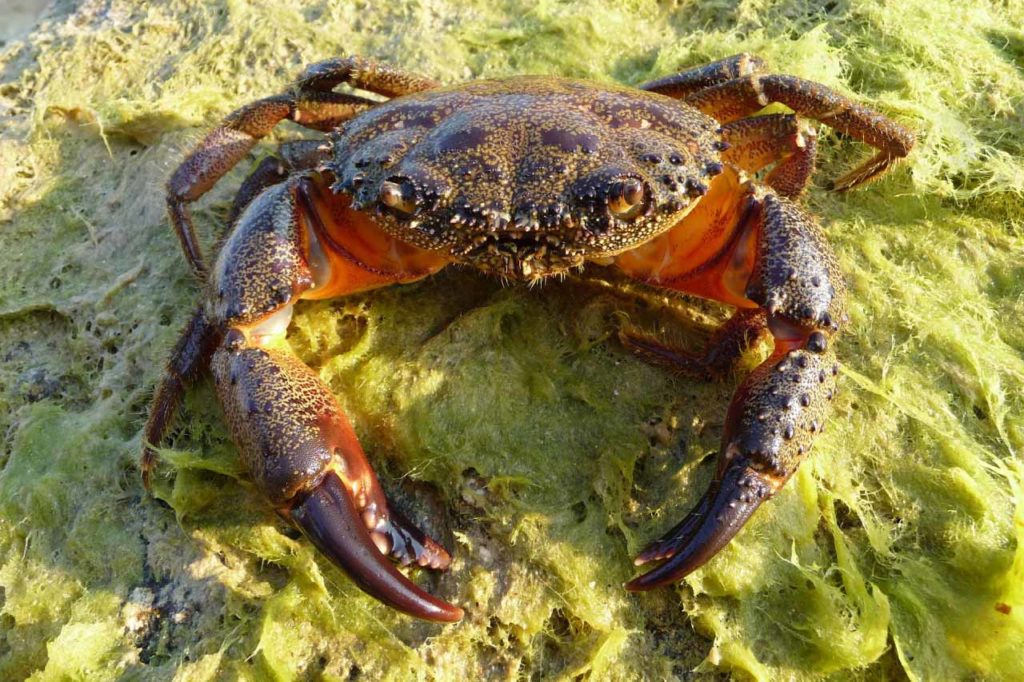
Crabs are members of the beast group Crustacea. Other crustaceans include lobsters, crayfish, krill and barnacles. Most crustaceans live in the ocean, simply some – such as woodlice – have adjusted to life on land.
A typical crab has five pairs of limbs. The front end pair is commonly modified into pincers, while the other four pairs are used for movement. Nearly crabs walk sideways rather than frontward.
Crabs are protected by a hard exoskeleton. As the crab grows information technology periodically molts, removing its unabridged body – including its legs – from its old shell. Its new shell is soft and expandable, giving the crab enough room to continue to grow.
Dolphin

Dolphins are marine mammals. Although their ancestors were land animals, dolphins are entirely aquatic. Their bodies are streamlined and fish-like, although, beingness mammals, dolphins still have to come up to the surface to breathe.
Well-nigh dolphins are members of the family Delphinidae, a grouping otherwise known as the oceanic dolphins. With 30 species, Delphinidae is the largest dolphin family.
Every bit the name suggests, oceanic dolphins are ocean animals. Members of the other three dolphin families live in freshwater or brackish (a mixture of fresh and salt water) habitats.
The brains of dolphins are amid the largest – in relation to torso size – of whatever beast. Dolphins are highly-intelligent animals, capable of teamwork, pedagogy / learning, and problem solving.
Find out more at Active Wild
- Common Bottlenose Dolphin Facts
- Dolphin Facts
Eel
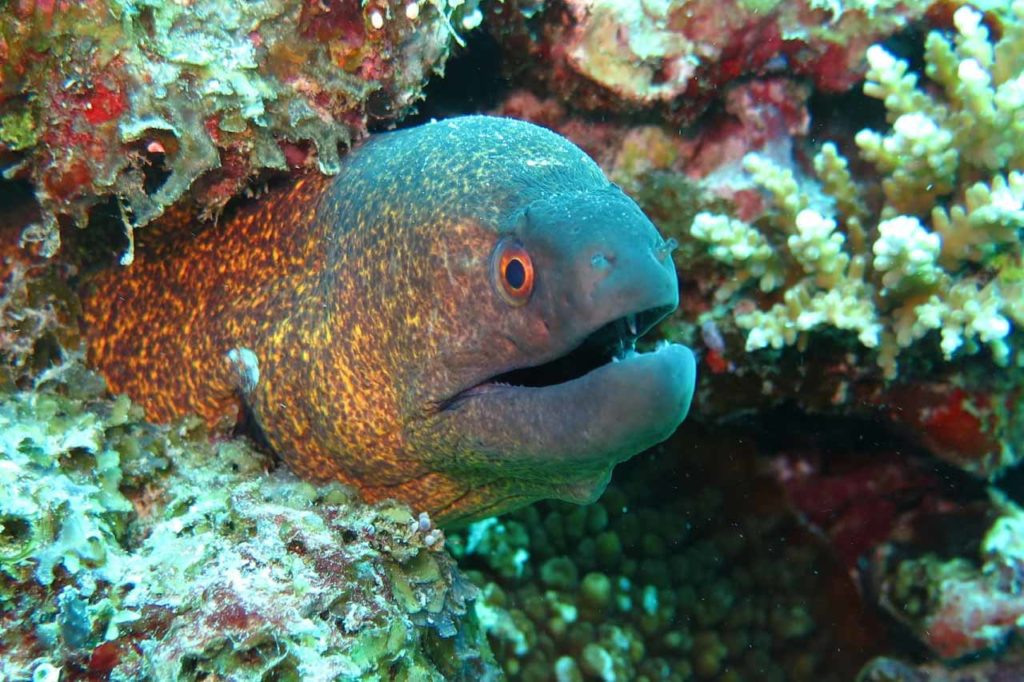
Eels are fish with long, snake-like bodies. Eels have long fins running forth much of the length of their bodies. They swim by moving from side to side, making waves that travel downward their bodies, pushing them through the h2o. Eels are too able to swim backwards.
There are around 800 species of eel. About live in the ocean, but some make their manner into freshwater habitats before returning to the sea to brood.
Eels brainstorm life equally tiny, translucent larvae that float in the sea for upward to iii years before they metamorphose into pocket-size eels. A juvenile eel is known as an elver.
Flatfish

Flatfish are fish with flattened bodies. Both of their eyes are positioned on the tiptop of their bodies. This means that, unlike most animals, flatfish are asymmetrical.
Flatfish are usually found either on or near the sea bed. The tops of their bodies are commonly darker than the undersides, providing camouflage confronting their surroundings.
As larvae, flatfish look like to other fish, with an eye on either side of their heads. As they pass from the larval to the juvenile phase of their evolution, one center (either the left or the right, depending on the species) migrates to the other side of the head. At the same time they begin to swim on their sides, and the skull and jaws go flattened.
Flatfish such equally halibut, plaice and flounder are important food fish for humans
Gull
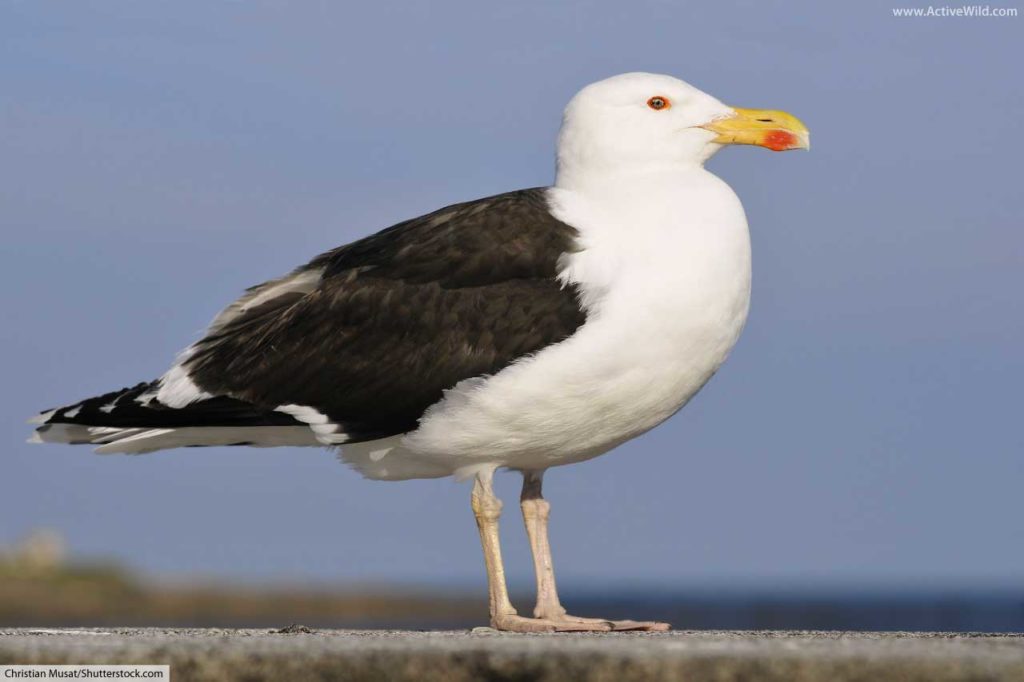
Gulls are a group of between l and 60 species in the family Laridae (this family also includes skimmers and terns). Gulls are medium to large birds, usually with white plumage with contrasting areas of grey or blackness. Most gulls are nighttime grey or brown as juveniles, becoming progressively whiter with each molt.
The slap-up blackness-backed gull is the largest species of gull. Information technology has a wingspan of between 144 and 166 cm.
Gulls are social, noisy birds. They traditionally form breeding colonies on rocks and cliff tops, simply today are just every bit likely to nest on rooftops in towns and cities. Gulls mate for life.
Jellyfish

Jellyfish, like sea anemones and corals, are members of the invertebrate group Cnidaria.
Jellyfish in the free-swimming, adult phase of their development accept circular, jelly-similar bodies (known as bells) with several abaft tentacles. A jellyfish in this stage of development is known as a medusa.
The tentacles of a jellyfish are equipped with stinging cells.
Although jellyfish stings are painful, they are ordinarily harmless to humans. Nonetheless, in some cases contact can be fatal. Box jellyfish (a type of jellyfish identified by their square-shaped bells) are the most unsafe to humans.
Jellyfish accept a complex life-cycle. They begin life as larvae. At this point they are gratis-swimming. The larvae and so attaches itself to a suitable surface and becomes a polyp.
The polyp then begins to produce buds. The buds float off and somewhen get medusae.
Notice out more than at Active Wild
- Lion's Mane Jellyfish Facts
Krill
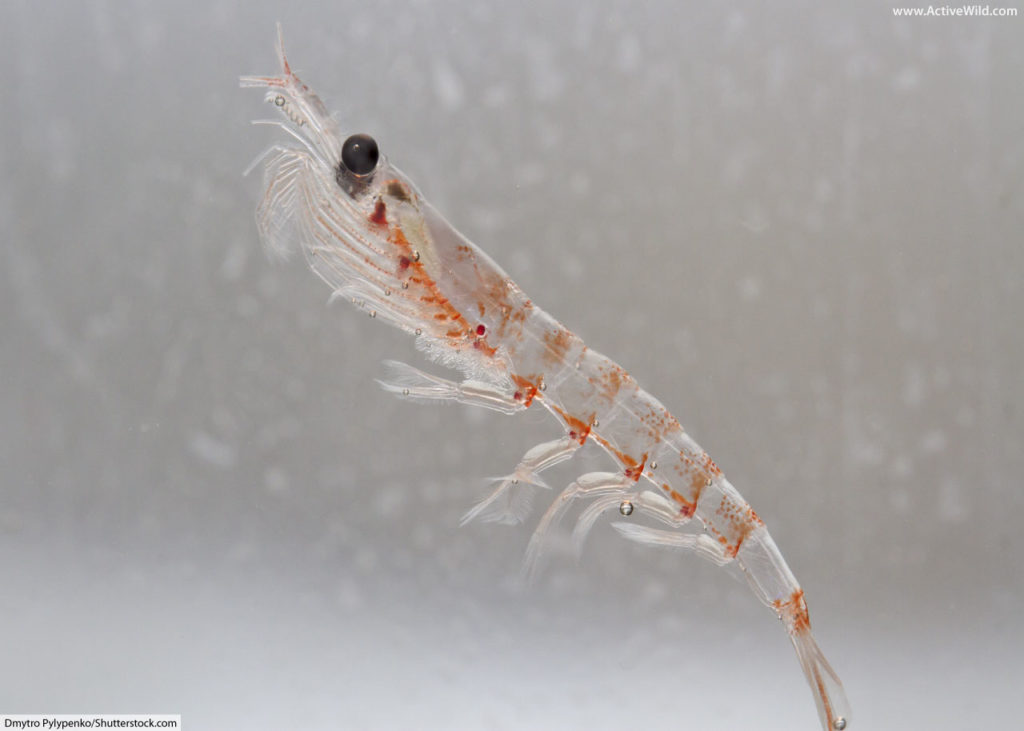
Krill may be pocket-size, but they play a vital office in the ocean food chain. Krill are crustaceans that spend their lives drifting in the ocean. During the daylight hours they are found in deep water, but during the dark they rise upwardly close to the surface.
In that location are 86 species of krill. Some of these species occur in such great numbers that their population makes upwardly a significant proportion of the total biomass of an ecosystem.
The total biomass of the Antarctic krill, a species found in the Antarctic ocean, may exceed 500 meg metric tons. This floating feast is an essential part of the diets of many species, including baleen whales, seals, squid, seabirds and fish.
Lobster

Lobsters are large crustaceans that alive on the sea bed. They have v pairs of limbs, with the front pair being equipped with large claws. The other four pairs are used for walking. The ii pairs behind the larger front limbs likewise possess claws.
Lobsters usually walk slowly over the sea floor, but if alarmed they are able to swim away backwards by curling and uncurling their tail.
Chemicals in the lobster's blood give information technology a blue color.
Killer Whale / Orca
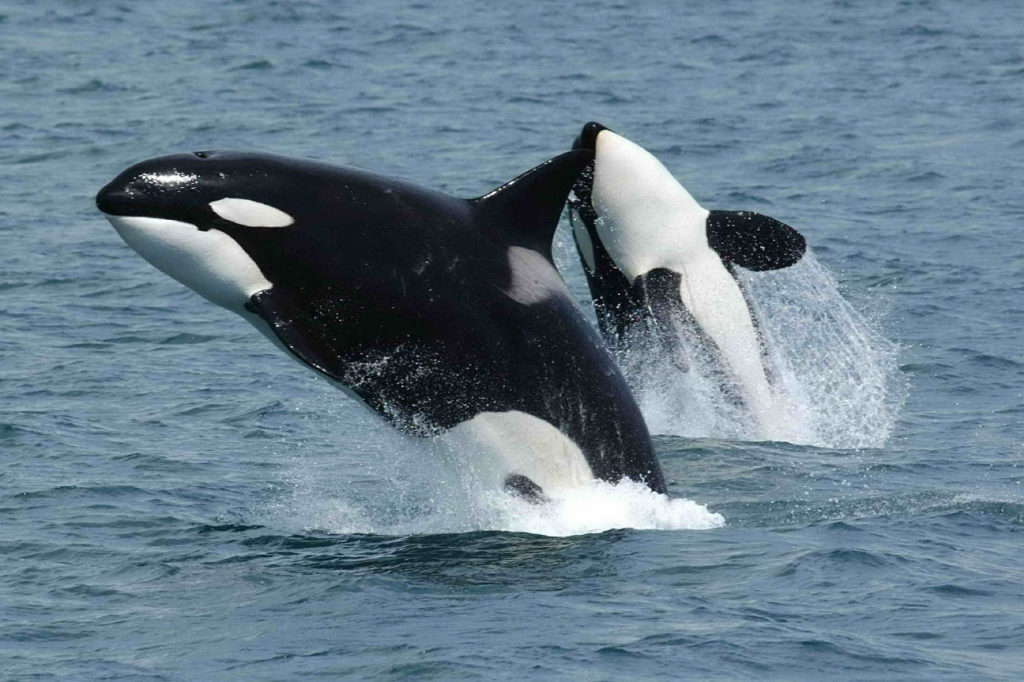
The killer whale – also known equally the orca – is 1 of the best-known sea animals. This fearsome carnivore is an apex predator, having no predators of its own.
The killer whale is institute in all of the world's oceans. It is just as likely to crop upward in the Antarctic ocean near Antarctica as it is in the Arctic.
Despite its name, the killer whale is actually a dolphin (although strictly speaking all dolphins, including the killer whale, are members of the group of animals known as toothed whales). It is a member of the family Delphinidae, also known as the oceanic dolphins.
With big males reaching eight meters in length and 6 metric tonnes in mass, the killer whale is the largest oceanic dolphin.
Notice out more than at Agile Wild
Killer Whale Facts
Penguin
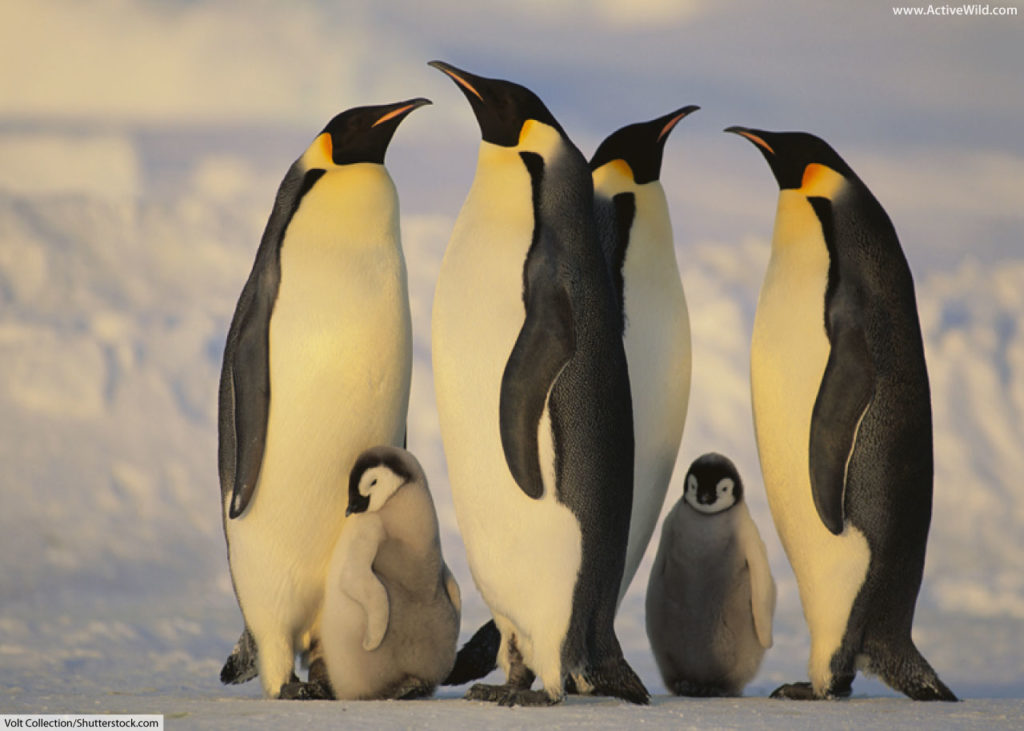
Penguins are flightless birds that are adapted to an aquatic lifestyle. Instead of flight through the air, penguins 'fly' through the h2o. Using their wings as flippers, penguins are fast and highly maneuverable. They have to be; their prey consists of sea animals such as fish, krill and squid.
Penguins are commonly constitute in cold regions in the Southern Hemisphere. Several penguin species are institute on the coast of Antarctica itself.
All penguins take black backs and white fronts. This is an example of countershading – a system of camouflage used by many sea animals – with the upper regions beingness darker than the underparts.
From below, the penguin is difficult to see against the surface of the water. From higher up, it is concealed against the ocean bed.
Some penguin species have additional markings and patches of yellowish or other colors.
The biggest penguin is the emperor penguin. It reaches a pinnacle of around ane.two m (4ft.). The smallest penguin is the fiddling penguin, which grows to around 33 cm (13 in.)
Discover out more than at Active Wild
- Types of Penguin
- Penguin Facts
- Lilliputian Penguin Facts
- Adélie Penguin Facts
- Emperor Penguin Facts
- Are Penguins Birds?
Ray

Rays are fish with broad, flat bodies and wing-like fins. Most rays are bottom-feeders, and many accept powerful, plate-similar teeth for crushing the shells and exoskeletons of their shellfish and crustacean casualty.
Rays, along with sharks, are members of the group known as the cartilaginous fishes. The skeletons of fish in this group are made from a flexible substance called cartilage, rather than of bone.
Some or all of the water taken in by rays for 'breathing' enters through openings called spiracles, which are positioned on the elevation of the ray's body. The water is then passed over the ray'due south gills. (Most fish take in h2o through the mouth alone.)
Stingrays are rays whose tails are equipped with sharp, venomous spines called stingers. These are normally merely used defensively.
Stings from stingrays usually occur when swimmers accidentally pace on the fish. The sting is extremely painful, but not normally life-threatening.
Discover out more at Active Wild
- Manta Ray Facts
Ocean Anemone

Ocean anemones are members of a group of invertebrates known as Cnidaria. Other cnidarians include jellyfish and corals.
Looking like underwater stars, bounding main anemones take a band of stinging tentacles positioned effectually a fundamental mouth.
Sea anemones brainstorm life every bit free-swimming larvae. Depending on the species, they then either adhere themselves to a solid surface or couch into soft surfaces.
Anemones are not completely immobile. Depending on the species they are able to motion in a diversity of ways, including crawling, swimming, or floating using a chimera of gas.
Some sea anemones have a symbiotic human relationship with other animals. (In nature, a symbiotic human relationship is one in which ii different species alive together and assist each other in some way.)
For example, some sea anemones live on the shells of hermit crabs. This gives the anemone a ways of moving effectually, while the anemone'due south stinging tentacles provide protection for the crab.
When the crab changes its beat out, it takes the sea anemone with him!
Bounding main King of beasts

Body of water lions are members of the eared seal family, Otariidae. This family is office of a larger group of animals known every bit pinnipeds, which also contains the true, or earless, seals, and the walrus.
Unlike true seals, body of water lions are able to use their hind flippers for walking on land. This makes them slightly more mobile when out of the water than their earless cousins.
There are half dozen species of sea panthera leo. The most familiar of these is the California body of water lion. This is the species that is usually seen in zoos and water parks.
Find out more at Active Wild
- California Bounding main King of beasts Facts
Ocean Snake

Body of water snakes are snakes in the family unit Elapidae that take adapted to life in the ocean. Non all members of this family live in the ocean; cobras, for example, live on land.
Most sea snakes spend their whole lives in the sea. They swim using their modified, paddle-like tails, and, rather than laying eggs, requite nascence to live young.
Sea snakes possess some of the most powerful venom of all snakes. This is delivered via hollow, fixed fangs positioned at the front of the upper jaw.
Sea Turtle

Sea turtles are a grouping of 7 reptiles that, unlike other Testudines (turtles) have adapted to a life spent mainly in the sea. In fact, once a male sea turtle enters the sea as a hatchling, information technology will never again walk on country.
Female sea turtles volition periodically return to country – ofttimes to the very embankment on which they hatched –in order to lay their eggs.
The limbs of ocean turtles have evolved into flippers. Although able to spend long periods of time under the water, sea turtles always have to return to the surface in society to breathe.
Sadly, sea turtles occasionally get caught up in the nets of line-fishing boats and drown. Bounding main turtles are too vulnerable to pollution, mistakenly eating pieces of plastic they find floating in the ocean.
This, combined with the loss of many of their traditional nesting areas, means that ocean turtles are in great danger.
Three sea turtle species are rated Vulnerable, one is rated Endangered, and two are rated Critically Endangered.
Observe out more at Active Wild
- Ocean Turtles: The Ultimate Guide
- Flatback Body of water Turtle Facts
- Green Body of water Turtle Facts
- Hawksbill Sea Turtle Facts
- Kemp's Ridley Ocean Turtle Facts
- Leatherback Ocean Turtle Facts
- Loggerhead Sea Turtle Facts
- Olive Ridley Ocean Turtle Facts
Seahorse

Seahorses are smallfish, named after the land mammals that they resemble. There are 45 species of seahorse.
Seahorses are not powerful swimmers. They spend most of the time holding onto marine vegetation with their prehensile tails. (Prehensile means 'able to grip'.)
Male person seahorses have pouches into which the female deposits eggs. The couple's eggs develop inside the pouch and the young sally as tiny seahorses.
Find out more at Active Wild
- Seahorse Facts
Seal

Seals are marine mammals whose ancestors were once land animals. Dissimilar whales and dolphins, whose ancestors were hoofed mammals, the ancestors of seals were carnivores.
Seals are in the same order – Carnivora – as cats, dogs, weasels and bears.
Seals have many adaptations for living in the ocean. These include having flippers for swimming, a layer of blubber under the skin for keeping warm, and streamlined, torpedo-shaped bodies for moving swiftly through the water.
In that location are two master types of seal: 'truthful seals' (as well known as 'earless seals') in the family Phocidae, and 'eared seals' in the family Otariidae.
Truthful seals propel themselves through the water using their hind flippers. This adaptation comes at a cost; their hind flippers cannot be used for walking. Considering of this, true seals move awkwardly on country.
The truthful seal family unit includes familiar species such as the harbor seal, which is the near widely-distributed seal, and the southern elephant seal – the largest seal species.
The eared seal family includes the fur seals and the bounding main lions. They swim mainly using their forepart flippers, and are able to contrary their hind flippers and utilize them for walking when on land.
Find out more at Agile Wild
- Antarctic Seals
- Leopard Seal Facts
- Southern Elephant Seal Facts
Shark
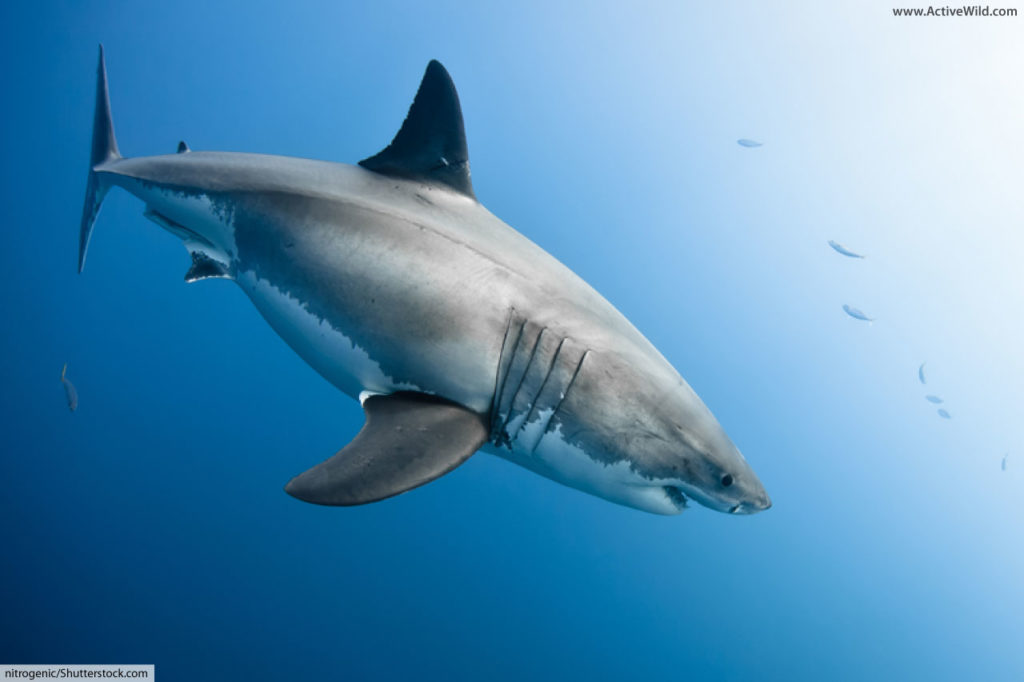
Sharks are among the best known – and virtually feared – of all sea predators. In that location are over 500 species of shark. Although not all are dangerous, species such every bit the great white shark, tiger shark and hammerhead shark are all apex predators; pinnacle of the food chain wherever they are plant.
Sharks are fast, silent, and nearly species are armed with a mouthful of sharp teeth that are replaced continuously throughout the animal's lifetime.
All sharks have special electroreceptive organs in their heads. Using these, a shark can sense the electric fields produced by other ocean animals. This 'sixth sense' is used to locate casualty.
Sharks are cartilaginous fish. Whereas the skeletons of bony fish (the other primary fish group) are made of bone, those of cartilaginous fish are fabricated of a flexible substance chosen cartilage.
The world'due south largest fish – the whale shark – and the second-largest fish – the basking shark – are both sharks. Unlike their smaller, but deadlier cousins, these two giants are filter feeders. Their diet consists of small marine organisms such every bit krill.
Find out more at Active Wild
- Basking Shark Facts
- Great Hammerhead Shark Facts
- Nifty White Shark Facts For Kids
- Greenland Shark Facts
- Tiger Shark Facts For Kids
- Whale Shark Facts
- Are Sharks Mammals?
- Facts About Sharks For Kids
Squid

Squid are mollusks in the class Cephalopoda. They have soft bodies with an internal shell called a pen, large eyes, a cluster of 8 arms and 2 tentacles. Like all mollusks, much of a squid's trunk is enclosed in a muscular wall known as a mantle.
The colossal squid – a squid that tin attain 46ft. (14 m) in length – has the largest eyes of any animate being. Its optics tin can be up to 11 in. (27 cm) in diameter!
Squid move through the water either by using their fins, or by jet propulsion. Jet propulsion is accomplished by ejecting water at loftier speed by contracting the curtain.
Starfish / Body of water Star

Starfish (besides known as bounding main stars) are invertebrate ocean animals in the order Asteroidea. (The name comes from the Greek for 'star-like').
Starfish alive on the ocean bed, where they feed on modest mollusks and other marine invertebrates.
Most starfish have five arms, but some species can have over l. If a starfish loses one or more of its arms, it can re-grow them!
Whale

Whales are marine mammals. Forth with dolphins and porpoises they course the grouping Cetacea – members of which are known as cetaceans.
Whales are descended from country animals. Their ancestors were hoofed mammals in the order Artiodactyla (a group of animals whose members are known equally 'even-toad ungulates'.
The cetaceans' closest living relatives on land are the hippopotamus and the pygmy hippopotamus.
There are two types of whale: toothed whales such as the killer whale and the sperm whale, and baleen whales such as the humpback whale and blue whale.
Baleen whales feed by filtering small organisms from the seawater using rummage-like structures in their toothless mouths. Toothed whales are cannibal predators.
Among the whales are some of the largest living animals. The blue whale (a baleen whale) is not just the largest living animal, information technology is also the largest animal that has ever lived.
Find out more than at Active Wild
- Antarctic Whales
- Beluga Whale Facts
- Blue Whale Facts
- False Killer Whale Facts
- Fin Whale Facts
- Grey Whale Facts
- Humpback Whale Facts
- Killer Whale Facts
- Whale Shark Facts
Worms

Worms are invertebrates with long bodies and no limbs. Many unrelated types of worm have adjusted to alive in the sea. Worms grade an important office of the marine nutrient chain, and can human action equally prey, scavengers, predators and parasites.
Many types of annelid (segmented worms whose bodies are made up of many rings, or segments) alive in the sea. This group includes worms such as lugworms and ragworms – both of which are eaten past other bounding main animals. Some ragworms are also predators themselves.
Sea worms such as osedax (also known as 'zombie-worms') are scavengers who help to interruption downwards the bodies of larger sea animals that accept sunk to the sea bed.
Some marine worms, such as the ribbon worm Parborlasia corrugatus, are parasites that live on the bodies of other sea animals while they are nonetheless alive.
The giant tube worm is a marine worm that is able to live in areas of high temperature and toxicity surrounding deep-sea volcanic vents.
Ocean Animals List For Kids & Adults: Conclusion
On this folio you've met a wide range of ocean animals, from littoral animals such as penguins that rely on the body of water for food, to deep sea worms that can survive in the almost inhospitable of habitats.
We promise that you've enjoyed reading about these amazing creatures and that you've discovered something about ocean animals that you lot didn't already know!
What'south your favorite ocean creature? Have we missed whatever animals that you recall should be on this list? Have you lot ever seen any of the animals mentioned on this page in the wild?
Let us know in the comments below; we'd love to hear from y'all!
Related Pages
- A to Z Animals List with Pictures & Facts
- Animals: The Ultimate Guide
- Rainforest Animals List
- Chill Animals List
- Antarctic Animals Listing
- African Animals Listing
- Australian Animals List
Source: https://www.activewild.com/ocean-animals/
Posted by: cartertherly.blogspot.com

0 Response to "What Kinds Of Animals Live In The Ocean"
Post a Comment